10 Yen Banknote from 1943
Hello Silver & Gold stackers! Today I am not in stacker mode, but back in numismatic mode and am bring you another Japanese banknote from my collection. This one is a more modern note so it's not too wild, but it's interesting all the same.
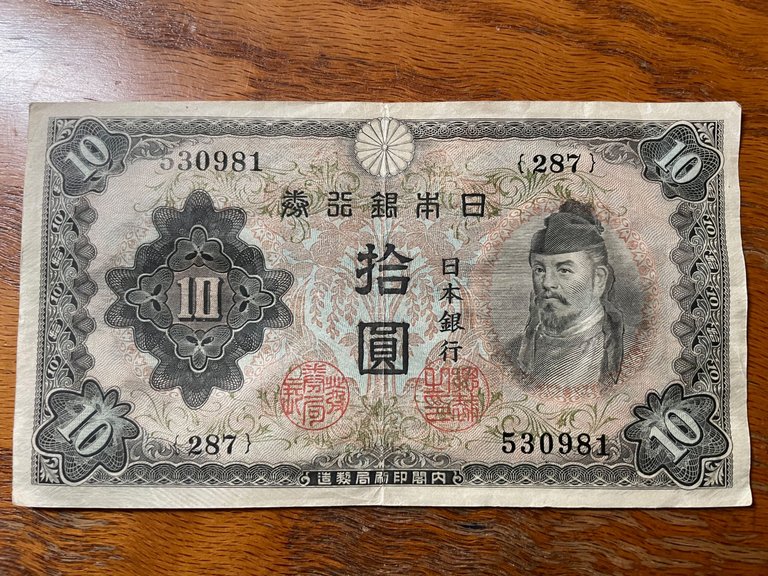
As you can see, this is a 10 yen banknote. It's from 1943, so this was around the time that the inflation caused by the war was starting to get out of control. Things hadn't spiraled into hyperinflation yet, but the yen was rapidly losing its value. Before the war, the yen was roughly equal to the US dollar, and after the war the yen plummeted to around ¥360 to the dollar. That's quite the fall!
In 1943 it hadn't yet fallen that low, but it had slipped to ¥3.15 per dollar. That was offically, anyway. Things were hard to come by in Japan during the war and even by 1943 the black market was the only way to get a lot of items. Prices there were much much higher, as you might expect, so in practice inflation was already significantly higher by this point.
That in mind, this ¥10 yen note wasn't as valuable as it would have been prewar, but it was still useful. Just to clarify things, with that ¥3.15/$1 exchange rate, this note would have been worth around $3, which adjusted for inflation would be around $54 today. So this was still a somewhat considerable amount, even if it was losing value day by day due to the war inflation.

The fellow you see on the front is Wake no Kiyomaro. He was a high-ranking official during the Nara period, which was way back in 710 to 794 when the capital city of Japan was located in Nara.
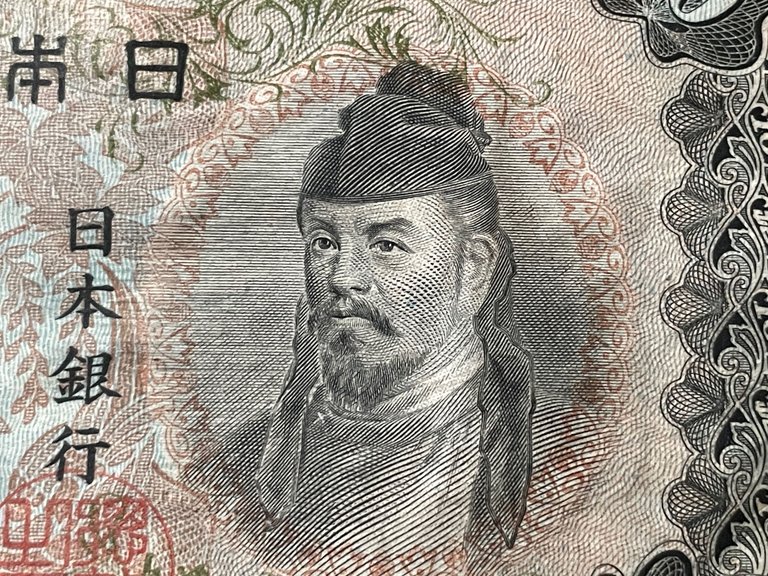
He was a trusted advisor to Emperor Kanmu and is famed for claiming to have received a divine message stating that only descendants of Amaterasu, the sun goddess, could become emperor. This assertion likely cemented his position within the imperial family but made him a powerful enemy in Dōkyō, a monk who had aspirations for the throne. Dōkyō responded by having Kiyomaro exiled and mutilating his legs. Only the intervention of the powerful Fujiwara clan saved Kiyomaro from death.
When Dōkyō eventually fell out of favor (and was himself exiled), Kiyomaro was reinstated and continued to be a significant influence, persuading the emperor to relocate the court from Nara to what is now Kyoto.
Let's go through some of the text we have here.
日本銀行券 (Nippon Ginkōken) means "Bank of Japan note". It appears reversed on the note because pre-war Japanese was written from right to left.
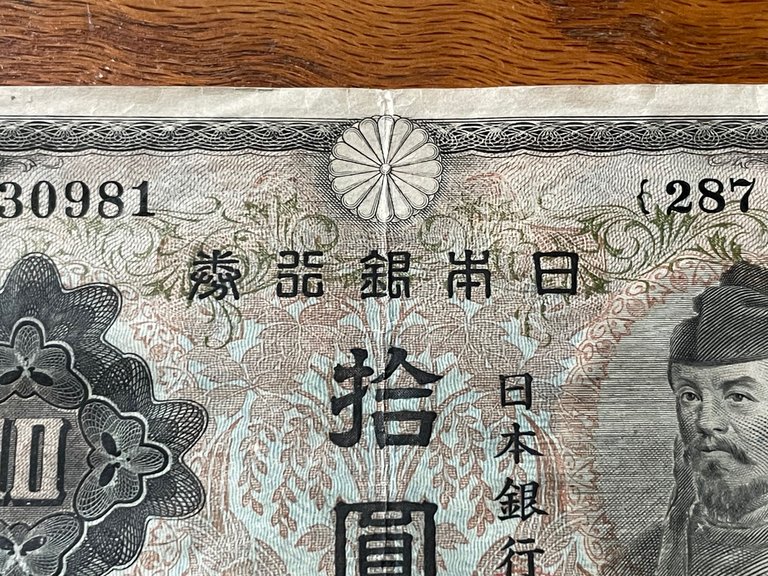
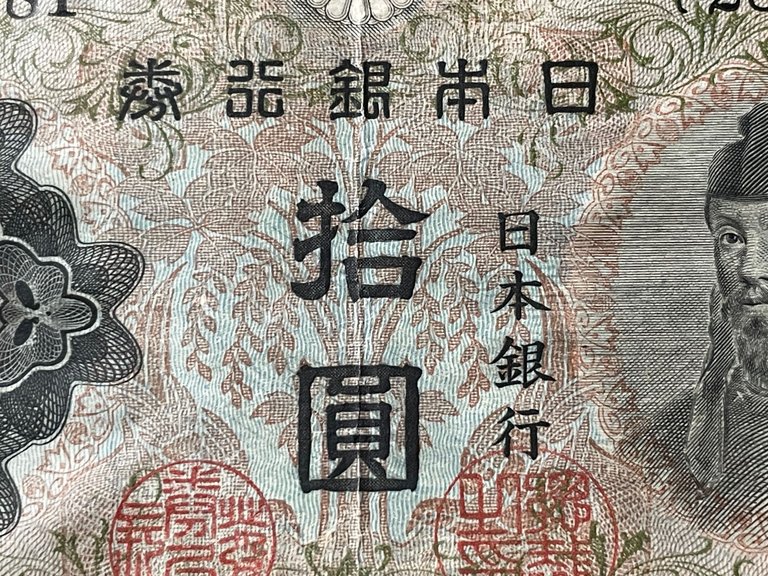
拾圓 (Jū En) means "ten yen". "Ten" is usually written as 十, but it appears as 拾 on banknotes to prevent tampering that could change the value of the kanji to a much higher amount. 圓 is the old pre-war way of writing 円.
Beside that, we have 日本銀行 (Nippon Ginkō), which means "Bank of Japan".
And at the very bottom, we have (again, it's reversed on the note) 内閣印刷局幣造, Naikaku Insatsukyoku Kaneizō, which means "Minted by the Cabinet Printing Bureau".
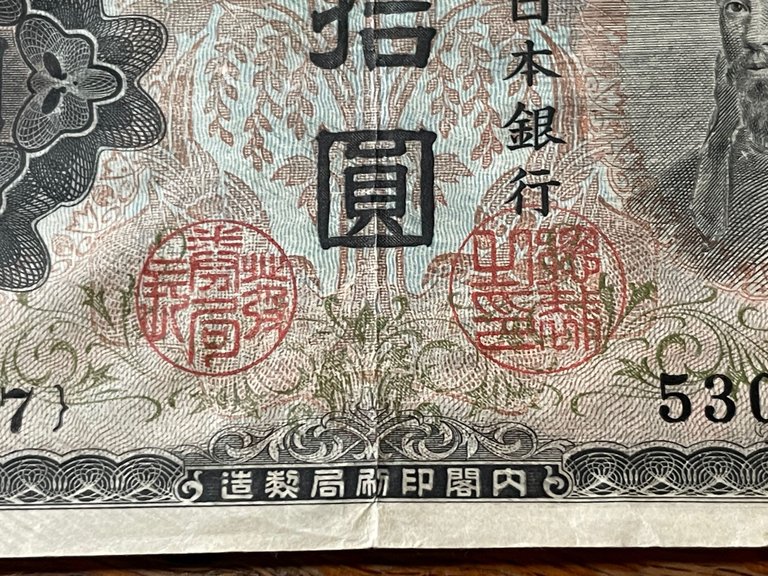
The back
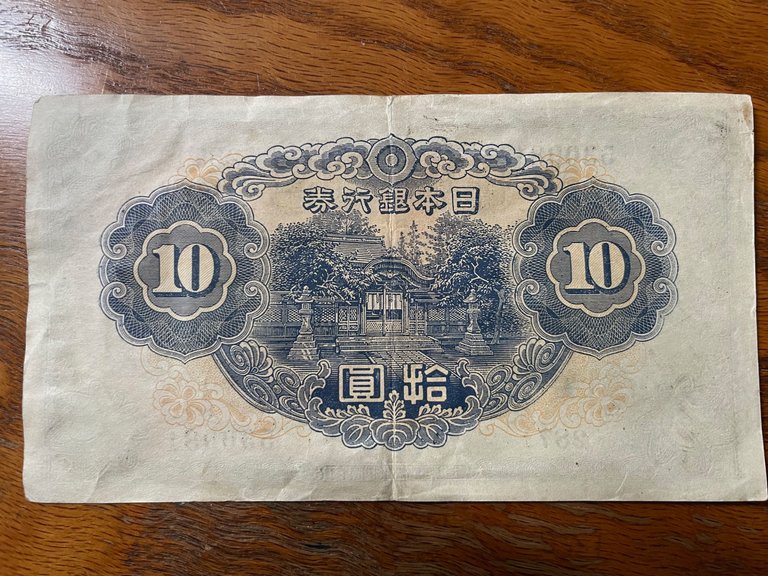
has a repeat of two of those phrases we saw on the front:
- 日本銀行券, "Bank of Japan note"
- 拾圓, "10 yen"
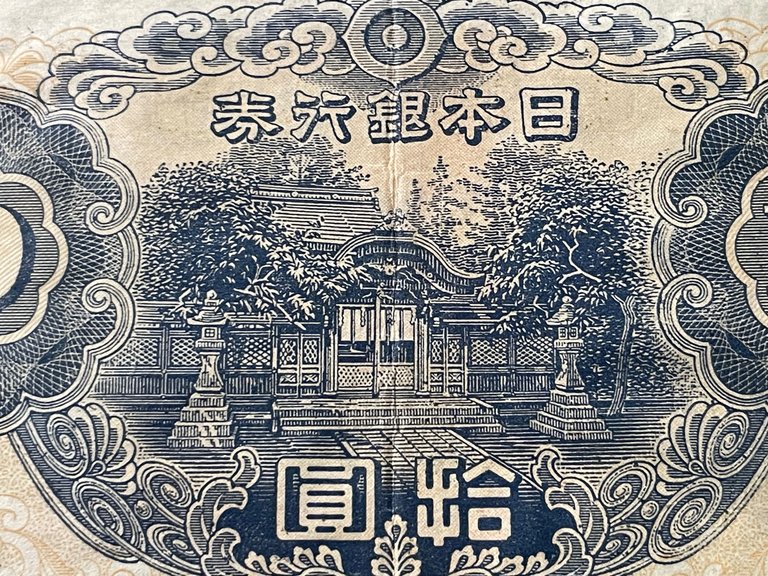
The location we see on the back is Goō Jinja, a shrine in Kyoto where Kiyomaro was enshrined. The shrine is also known as "Wild Boar shrine". This is due to an interesting bit of folklore. It's said that when Kiyomaro was traveling to his exile destination (a place called Usa—pronounced u-sah, u as in uber) he was having a hard time walking, due to that nasty leg injury inflicted upon him by Dōkyō. This made travel slow. This slow travel allowed assassins sent by Dōkyō to try to finish the job. 300 wild boars suddenly showed up to protect him from the assassins and they stayed with him until the end of his journey. Furthmore, it is said that as soon as the boars departed, his legs magically healed.
So, not only does the shrine take the nickname "wild boar" shrine due to this folklore, but people travel from all over the country to this shrine to pray for recovery from lower-body injuries.
Due to this story, ¥10 banknote were commonly referred to as "boars".
Anyway, it's a great historic banknote.
Here it is compared with some of the other old banknotes I've talked about in past posts:
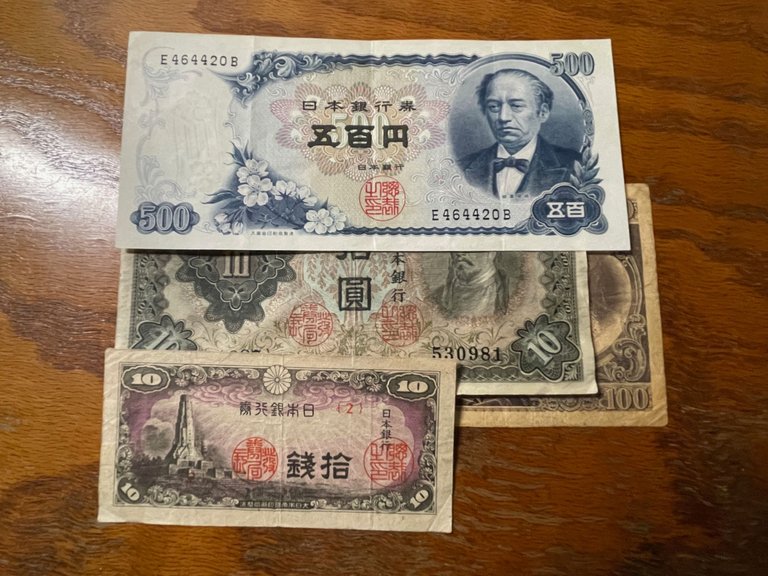
❦
 |
David LaSpina is an American photographer and translator lost in Japan, trying to capture the beauty of this country one photo at a time and searching for the perfect haiku. He blogs here and at laspina.org. Write him on Twitter or Mastodon. |
You received an upvote of 100% from Precious the Silver Mermaid!
Thank you for contributing more great content to the #SilverGoldStackers tag.
You have created a Precious Gem!
This post has been manually curated by @bhattg from Indiaunited community. Join us on our Discord Server.
Do you know that you can earn a passive income by delegating your Leo power to @india-leo account? We share 100 % of the curation rewards with the delegators.
100% of the rewards from this comment goes to the curator for their manual curation efforts. Please encourage the curator @bhattg by upvoting this comment and support the community by voting the posts made by @indiaunited.
👏 Keep Up the good work on Hive ♦️ 👏
❤️ @bhattg suggested sagarkothari88 to upvote your post ❤️
🙏 Don't forget to Support Back 🙏
That getting to look like a fine banknote collection, thinking of having them stored in an expandable album?
Yeah I really should buy an album or at least some plastic sleeves for them. Do you have any recommendations?
Most coin shops will carry currency various sized sleeves, album 3 Ring Binder style or Billfold single styled. Brands like Lighthouse, Grande, UniSafe, etc. I have a modest collection of international paper money but I know @punkysdad has a much bigger banknote collection than I do. I often borrow an odd bill from him and offer a 5% beneficiary if I use it on a post.
Happy Collecting @dbooster
🤩 👍 !PGM
Thats pretty interesting to watch what happened to the money during wartime. Fiat money is war money for sure. It is amazing to think we haven't had any hard money in my lifetime until now.
Isn't that nuts? We have only had play money for so long. Whenever I look at historic values and do the math to find out how badly inflation has screwed us, I'm shocked.
It's a strange feeling to have money that works as it should. I'm loving it!
Wow, the texture on that is really cool. The art of course is amazing as well. What a nice piece of your collection!
I like that it is also taller and more square. It's interesting that Japanese notes had (and still have) different sizes so you can tell them apart easier.
That is pretty interesting. Seems to make more sense to me.
Nice piece, love it!
Wow. Inflation is a bitch. Growing up I heard my folks (who were born in 1924 and 1931) talk about how much prices had risen since they were kids. But it didn't really hit me just how much inflation has screwed us over until seeing your comparison here. $3 when they were teens bought the same amount of stuff as $54 today?
Yeah. Maybe stacking is a good idea regardless of whether the SHTF.
!PIZZA
Yeah, exactly. Your folks lived through watching the value of their money disappear. Inflation has robbed us of much. A dollar in 1913, the year the FED was created, would be $31.67 today. That one is easiest to see when we think that at the time they still used near an ounce of silver in the silver dollars, and that same ounce would be close to $30 today. To flip that around, today's dollar would be worth about 3 cents in 1913 money.
[see: the inflation calculator]
Yeah, I don't think things are going to fall apart anytime soon. But even so, stacking is a good way to maintain your wealth in a more stable way.
$PIZZA slices delivered:
@willendorfia(4/15) tipped @dbooster
If I had more yen I would feel zen 😂 !BBH
@dbooster! Your Content Is Awesome so I just sent 1 $BBH (Bitcoin Backed Hive) to your account on behalf of @bitcoinman. (11/50)